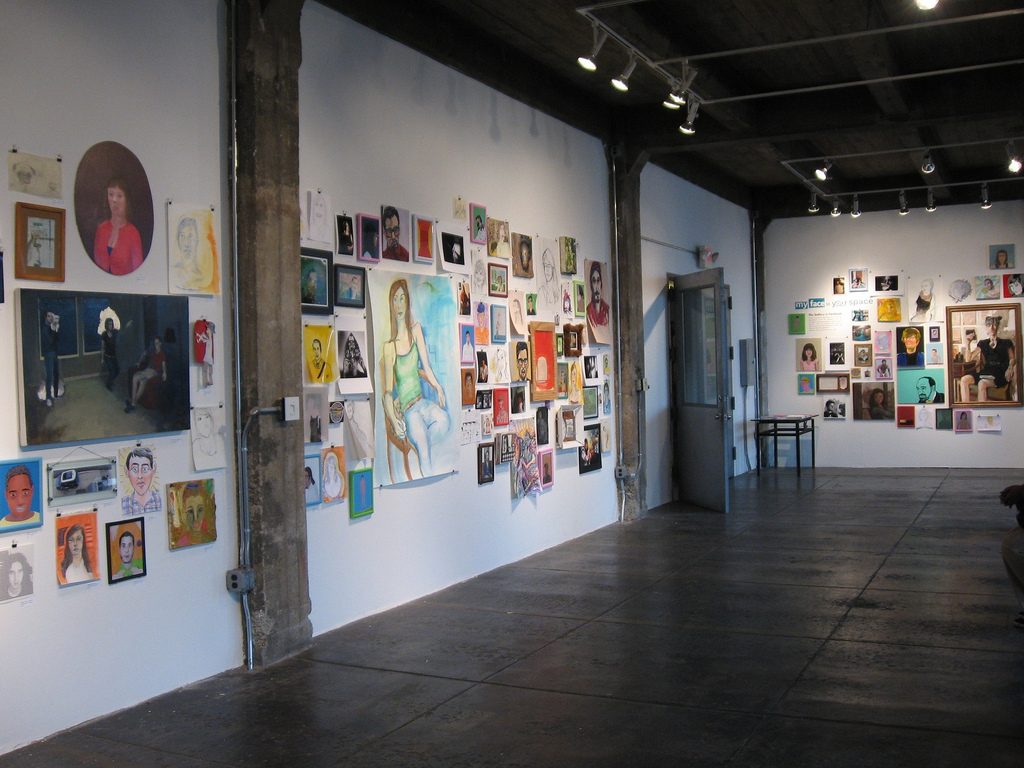With this exhibition, several artists were selected to draw portraits of their friends and acquaintances under the agreement that their portraitees would reciprocate and do the same. Once their friends had been entered into the network, they would be able to do portraits of whomever they liked under the same reciprocal agreement. The installation is designed to be ongoing, allowing for new members of the network to hang their work up until the final day of the exhibition Friday October 2, 2009.

Some thoughts on the exhibition
Origins. This project was conceived a few years ago. The concept was developed collaboratively through a series of late night discussions that typically used “wouldn’t it be fun if …” as the starting point. Originally, it was going to be manifested as a series of temporary tattoo portraits that was springboarded from an earlier project involving stamping portraits on people’s bodies at the Fringe Festival. The idea seemed fun, relevant and certainly novel due to the technology involved, but had some drawbacks as it wouldn’t allow for a truly inclusive (democratic, populist) experience that would be limited to my own circle of acquaintances. The idea evolved into this more pluralistic approach, mostly based on the explosion of social media websites in the past few years and the notion that “a network of friends” actually existed in real life. The idea then became “Wouldn’t it be fun to mimic facebook in the gallery with portraits and to see a physical version of the website?” and also “Wouldn’t it be fun if there wasn’t a curatorial theme but that inclusion was based simply on the request from a friend?”
In order for this project to work in the way I envisioned, it would be important to start with a few well connected “seeds.” These project “seeds” included Austin Lee, Melissa Zetts, Molly Mullahy, Tasha Doremus and Ted Adams; a cross generational selection of artists connected to diversely different networks. My hope was that the reciprocation would extend beyond the first generation and into a second, third, forth etc… generation. I’m happy to report that it did and that there are quite a few artists in the show that I don’t know.
Portraits. The project developed out of my own interest in drawing portraits. Portraiture allows for a very intimate connection with another individual because it allows you to stare, unabashedly, at someone else’s face; something that if you were caught doing in public might provoke evil stares back. Of the many thoughts that go through my head as I’m drawing someone, some of the most compelling is how I know the person and what kind of history we share.
Technology. My Face in Your Space is not an anti-technology, anti-facebook statement. Quite the contrary, the show reflects on how a lot of this technology has allowed for old friends to reconnect and how it maintains your connections with people you know. This show wouldn’t be as strong and as wide ranging had it not been for this technological advantage. Part of the fun in this show, I think, is finding the connections between the portraitees; who drew who, what do a lot of the portraits have in common, what features of someone are collectively observed.
Networking. Here’s some free professional development advise. I find “networking” to be one of the most offensive business-speak words. To be a good “networker” all you really just need is to be good at making friends. If you can make friends – a lot, or a little – that’s really all you need; someone you know always know someone who can put you in touch with someone else.
Thanks. I owe a thank you to a friend, Jeremy Adams, director of Cue Foundation in NYC who introduced me to the term “pluralistic” in describing their programming approach.
Thanks also to my interns Kate Borbas and Sheila Whitsett for all their help.
My further undying thanks to the NEXUS membership (really the Super Friends of Philadelphia) for putting up with my absurd ideas.

